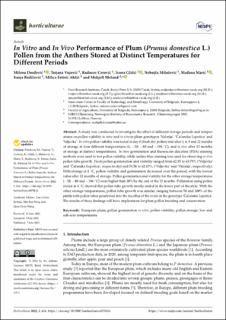| dc.contributor.author | Ðorđević, Milena | |
| dc.contributor.author | Vujović, Tatjana | |
| dc.contributor.author | Cerović, Radosav | |
| dc.contributor.author | Glišić, Ivana | |
| dc.contributor.author | Milošević, Nebojša | |
| dc.contributor.author | Marić, Slađana | |
| dc.contributor.author | Radičević, Sanja | |
| dc.contributor.author | Akšić, Milica Fotirić | |
| dc.contributor.author | Meland, Mekjell | |
| dc.date.accessioned | 2022-10-31T10:07:58Z | |
| dc.date.available | 2022-10-31T10:07:58Z | |
| dc.date.created | 2022-09-30T10:25:43Z | |
| dc.date.issued | 2022-07-07 | |
| dc.identifier.citation | Horticulturae. 2022, 8 (7), 1-14. | en_US |
| dc.identifier.issn | 2311-7524 | |
| dc.identifier.uri | https://hdl.handle.net/11250/3029069 | |
| dc.description.abstract | A study was conducted to investigate the effect of different storage periods and temperatures on pollen viability in vitro and in vivo in plum genotypes ‘Valerija’, ‘Čačanska Lepotica’ and ‘Valjevka’. In vitro pollen viability was tested at day 0 (fresh dry pollen) and after 3, 6, 9 and 12 months of storage at four different temperatures (4, −20, −80 and −196 °C), and in vivo after 12 months of storage at distinct temperatures. In vitro germination and fluorescein diacetate (FDA) staining methods were used to test pollen viability, while aniline blue staining was used for observing in vivo pollen tube growth. Fresh pollen germination and viability ranged from 42.35 to 63.79% (‘Valjevka’ and ‘Čačanska Lepotica’, respectively) and 54.58 to 62.15%, (‘Valjevka’ and ‘Valerija’, respectively). With storage at 4 °C, pollen viability and germination decreased over the period, with the lowest value after 12 months of storage. Pollen germination and viability for the other storage temperatures (−20, −80 and −196 °C) were higher than 30% by the end of the 12 months. Pollination using pollen stored at 4 °C showed that pollen tube growth mostly ended in the lower part of the style. With the other storage temperatures, pollen tube growth was similar, ranging between 50 and 100% of the pistils with pollen tubes penetrated into the nucellus of the ovule in the genotype ‘Čačanska Lepotica’. The results of these findings will have implications for plum pollen breeding and conservation. | en_US |
| dc.language.iso | eng | en_US |
| dc.publisher | MDPI | en_US |
| dc.rights | Navngivelse 4.0 Internasjonal | * |
| dc.rights.uri | http://creativecommons.org/licenses/by/4.0/deed.no | * |
| dc.title | In Vitro and In Vivo Performance of Plum (Prunus domestica L.) Pollen from the Anthers Stored at Distinct Temperatures for Different Periods | en_US |
| dc.title.alternative | In Vitro and In Vivo Performance of Plum (Prunus domestica L.) Pollen from the Anthers Stored at Distinct Temperatures for Different Periods | en_US |
| dc.type | Peer reviewed | en_US |
| dc.type | Journal article | en_US |
| dc.description.version | publishedVersion | en_US |
| dc.rights.holder | © 2022 by the authors | en_US |
| dc.source.pagenumber | 1-14 | en_US |
| dc.source.volume | 8 | en_US |
| dc.source.journal | Horticulturae | en_US |
| dc.source.issue | 7 | en_US |
| dc.identifier.doi | 10.3390/horticulturae8070616 | |
| dc.identifier.cristin | 2057064 | |
| dc.relation.project | Norges forskningsråd: 280376 | en_US |
| dc.source.articlenumber | 616 | en_US |
| cristin.ispublished | true | |
| cristin.fulltext | original | |
| cristin.qualitycode | 1 | |

